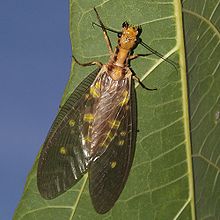- Dobsonfly
-
Dobsonfly 
Protohermes grandis Scientific classification 
Kingdom: Animalia Phylum: Arthropoda Class: Insecta Order: Megaloptera Family: Corydalidae Subfamily: Corydalinae Genera - Acanthacorydalis
- Chloronia
- Chloroniella
- Corydalus
- Dysmicohermes
- Hermes
- Neohermes
- Neoneuromus
- Neurhermes
- Nevromus
- Platychauliodes
- Platyneuromus
- Protohermes
A Dobsonfly is any insect of the subfamily Corydalinae, part of the megalopteran family Corydalidae. There are over 220 species of dobsonflies. Dobsonflies are found throughout the Americas and Asia, as well as South Africa. Their closest relatives are the fishflies.
 A hellgrammite
A hellgrammite
Both male and female dobsonflies can reach lengths up to five inches (12.5 cm), measured from the tips of their pincers to the tips of their four wings. Their wingspans can be twice as long as their body length. The wings are densely lined with intersecting veins. When not in use, the wings are folded along the length of their bodies. Dobsonflies have long, multi-segmented antennae.
Though both male and female dobsonflies have sharp mandibles, those of an adult male dobsonfly are actually so big – up to 1 inch (25 mm) – that they are unable to harm humans, as they have such poor leverage that they are incapable of breaking the skin. Their mandibles are used exclusively during mating, where males show them off and grasp the females during copulation. Female dobsonflies, however, retain the short, powerful pincers they had as larvae, so they can inflict painful bites, which can draw blood. Notwithstanding the males' inability to inflict harm, when threatened both sexes will raise their heads and spread their jaws menacingly. They are not venomous, but possess an irritating, foul-smelling anal spray as a last-ditch defense.
Dobsonflies spend most of their life in the larval stage, during which they are called hellgrammites, and are familiar to anglers who like to use the large larvae as bait. Hellgrammites live under rocks at the bottoms of lakes, streams and rivers, and prey on other insect larvae with the short sharp pincers on their heads, with which they can also inflict painful bites on humans. The larvae reach to 2" to 3" in length, with gills all along the sides of their segmented bodies that allow them to extract oxygen from water.
After a few years of living and growing underwater, the larvae crawl out onto land and pupate. They stay in their cocoons over the winter and emerge only to mate. Upon emerging, they live for only seven days. While not generally believed to eat during their adult stage, some captive female specimens have been observed with their heads burrowed into blackberries[citation needed].
Adults can generally be found from late spring into the middle of summer, preferring to remain near bodies of water, particularly the ones where they grew up. Once they emerge as adults they mate, deposit their eggs near the water (often on overhanging vegetation), then die. They are primarily nocturnal, and like most aquatic insects, are commonly attracted to bright lights.
Etymology
References to the names "dobson" and "hellgrammite" (both referring to the larvae) date back at least to the late 1800's[1][2], but to date there is only speculation as to the actual origin of these names[3].
External links
- http://www.fcps.k12.va.us/StratfordLandingES/Ecology/mpages/dobsonfly.htm
- http://mbgnet.mobot.org/fresh/slide/dobson.htm
- http://insects.tamu.edu/fieldguide/bimg121.html
- http://tolweb.org/tree?group=Corydalus&contgroup=Corydalinae
- Dobson Fly page at "What's That Bug"
- Hellgrammite page at "What's That Bug"
- Corydalus cornutus, eastern dobsonfly on the UF / IFAS Featured Creatures Web site
- Video of hellgrammites
Categories:
Wikimedia Foundation. 2010.


